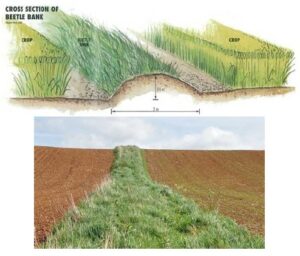Usually, our first thought when we see a bug in a field is a pest. Pests can kill, defoliate, and consume entire leaves. If there is an abundance of pests they can do a bunch of damage to an entire field and drastically lower the yield of the field. There are many common pests to watch out for. A common practice to eliminate these pests is using pesticides. Unfortunately, there can be many negative effects when using pesticides. Pesticides are great for eliminating pests, but they also kill all other insects that benefit the alfalfa. Let’s distinguish the difference between pests and beneficial bugs and learn how to get rid of pests without using harmful pesticides.
Scouting and Monitoring
Scouting for pests is a great way to stay on top of things and monitor when to take action. One way to monitor is to do a visual inspection. Count and record the numbers and kinds of pests that are on the plants and the soil. Also, keep an eye out for plant injury from pests. Another way to monitor is by net sampling. Use a heavy, muslin, 15-inch diameter net to sweep in the fields. This is a very effective method for collecting insects in hay fields. Swing the net back and forth through the plant canopy while walking. Then, stop and note (and count, if possible) both pests and beneficial species. The last way to monitor is light trapping. Use light traps to determine the first occurrences and relative abundance of insect species. This method is especially important for monitoring armyworm and potato leaf hopper populations.
Identifying Insects
PESTS (FOE)
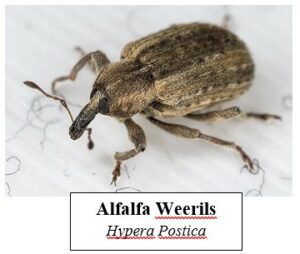 Appearance: Adults are brown with a darkened, V-shaped marking on their back. They have a pronounced snout. Larvae are green to yellowish-green with dark heads and a pale-yellow to white dorsal stripe. Adults are roughly 1/4 inch long and larva range in size from 1/16 to 5/8 inch long.
Appearance: Adults are brown with a darkened, V-shaped marking on their back. They have a pronounced snout. Larvae are green to yellowish-green with dark heads and a pale-yellow to white dorsal stripe. Adults are roughly 1/4 inch long and larva range in size from 1/16 to 5/8 inch long.
Life Cycle: Egg – Larva (4 stages) – Pupa – Adult. Alfalfa weevils have one generation per year. Later, larger instars shred or skeletonize leaves. Fields with severe leaf damage will appear gray. Adult feeding is normally minimal and located on lower leaf margins after first cutting.
Damage: First sign of larvae damage is pinholes in leaves, particularly near the stem growing point.
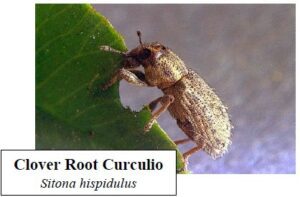 Appearance: Adults are small, brown weevils, with a slightly checkered appearance. Unlike alfalfa weevils, clover root curculio have a broad snout and are slightly smaller in size. Larvae are white, opaque, and grub-like with reddish-brown heads. Adults are 3/8 inch in length and larvae are 1/4 long when fully grown
Appearance: Adults are small, brown weevils, with a slightly checkered appearance. Unlike alfalfa weevils, clover root curculio have a broad snout and are slightly smaller in size. Larvae are white, opaque, and grub-like with reddish-brown heads. Adults are 3/8 inch in length and larvae are 1/4 long when fully grown
Life Cycle: Egg – Larva – Pupa – Adult. Clover root curculio have one generation per year.
Damage: In fall, young larvae feed on the nitrogen- fixing nodules and lateral roots and legumes. In spring, larvae feed on the main taproots. The lesions caused by this feeding may also girdle roots. Plant stands are often reduced in patchy areas. Clover root curculios are most common in older stands.
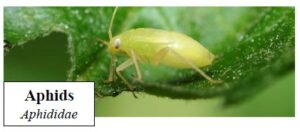 Appearance: Aphids are small, soft-bodied insects that have a pair of backward pointing tubes on the abdomen called cornicles. Some life stages possess wings. Common species include pea aphids (green, long legs and antenna), spotted alfalfa aphids (speckled), and cowpea aphids (black or grey with pale yellow legs and antennae). Aphid sizes range from 1/32 – 1/8 inch.
Appearance: Aphids are small, soft-bodied insects that have a pair of backward pointing tubes on the abdomen called cornicles. Some life stages possess wings. Common species include pea aphids (green, long legs and antenna), spotted alfalfa aphids (speckled), and cowpea aphids (black or grey with pale yellow legs and antennae). Aphid sizes range from 1/32 – 1/8 inch.
Life Cycle: Egg – Nymph – Adult. During the summer, they reproduce asexually giving birth to live young, allowing them to multiply very quickly
Damage: Adults and nymphs suck plant juices, and when abundant, cause plants to yellow and wilt. Pea aphids damage first cutting and reduce stands for subsequent harvests.
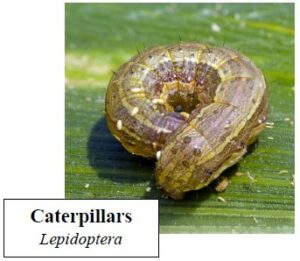 Appearance: Many caterpillar species eat alfalfa. Armyworms and cutworms (noctuid moth larvae) have smooth bodies and are variable in color with brown, black, yellow, or pale striping. Alfalfa caterpillars (larvae of yellow or white butterflies) have velvety green bodies with a prominent white stripe along each side. Caterpillars range from 1/8 inch to 2 inches long when fully grown.
Appearance: Many caterpillar species eat alfalfa. Armyworms and cutworms (noctuid moth larvae) have smooth bodies and are variable in color with brown, black, yellow, or pale striping. Alfalfa caterpillars (larvae of yellow or white butterflies) have velvety green bodies with a prominent white stripe along each side. Caterpillars range from 1/8 inch to 2 inches long when fully grown.
Life Cycle: Egg – Larva – Pupa – Adult. Multiple generations can occur in a single year.
Damage: Ragged leaves to complete crop defoliation. Cutworms can be an economic concern in new forage stands. Armyworm outbreaks can rapidly defoliate forages.
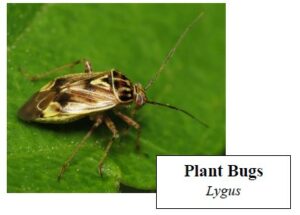 Appearance: Coloration is pale green to yellow with brown markings. Adults have a distinctive heart-shaped marking on their back. Young nymphs can be mistaken for pea aphids but lygus nymphs are more mobile and have thicker antennae. Older nymphs have well-defined wing pads. Adult size is about 1/4 inch in length while nymphs are 1/16 – 1/8 inch long.
Appearance: Coloration is pale green to yellow with brown markings. Adults have a distinctive heart-shaped marking on their back. Young nymphs can be mistaken for pea aphids but lygus nymphs are more mobile and have thicker antennae. Older nymphs have well-defined wing pads. Adult size is about 1/4 inch in length while nymphs are 1/16 – 1/8 inch long.
Life Cycle: Egg – Nymph (5 stages) – Adult. There are multiple generations per year (2-3).
Damage: Adults and nymphs use piercing-sucking mouthparts to damage leaves, stems, flowers, seeds, and seed pods. They inject saliva into plant tissues which causes severe plant damage. Feeding damage can cause cell death, resulting in crinkled, discolored tissues and nonviable seeds.
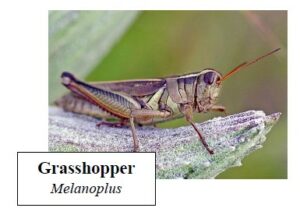 Appearance: Grasshoppers have enlarged hind legs for jumping and are variable in color and size.
Appearance: Grasshoppers have enlarged hind legs for jumping and are variable in color and size.
Adults are gray to brown with wings held together vertically over the body. Nymphs are visually similar, but smaller and without fully developed wings. Adults can be 1- 2 inches long while nymphs can be 1/4 – 1 3/4 inch long depending on the species.
Life Cycle: Egg – Nymph (5 stages) – Adult. Most grasshoppers have one generation per year. Eggs are laid in the soil during summer and fall.
Damage: Leaves have irregular notches from the margins inward, leaving ragged edges. Feeding may damage growing tips.
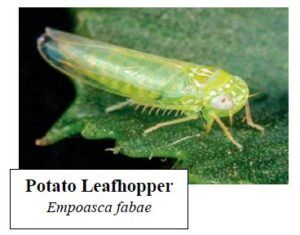 Appearance: Potato leafhopper adults are very small (3/16-inch), greenish-yellow, wedge-shaped insects. The nymphs resemble the adults; however, nymphs are smaller (1/16-1/8-inch), more yellowish, and wingless.
Appearance: Potato leafhopper adults are very small (3/16-inch), greenish-yellow, wedge-shaped insects. The nymphs resemble the adults; however, nymphs are smaller (1/16-1/8-inch), more yellowish, and wingless.
Lifecycle: Adults live 30-40 days but may live as much as 90 days. Two to three small white eggs are laid per day onto stems or large leaf veins, and 200 eggs per adult life is possible. Tiny nymphs emerge from these eggs in seven to 10 days, molt five times over a period of approximately two weeks and then turn into adults.
Damage: Nymphs cause the most damage to plants by sucking the plant juices and injecting toxins into the plant. The first symptom is a wedge-shaped yellowing of leaf tips (called hopper-burn). Left unchecked, the yellowing spreads over the entire leaf and may stunt stands and reduce quality and stands. Advanced damage can appear reddish-bronze. Potato leafhoppers also infest birdsfoot trefoil and white clover.
BENEFICIAL BUGS (FRIEND)
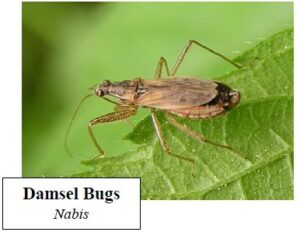 Appearance: Slender-bodied insects that range in color from grey to golden brown. Raptorial forelegs are used for grasping and holding onto prey, much like a praying mantis. They have piercing-sucking mouthparts that are held underneath the body when at rest, but extend forward to feed. Nymphs are similar in appearance to adults but are smaller in size and have developing wing pads. Adult size is approximately 1/4 inch in length while nymphs are 1/16 to 1/4 inch long.
Appearance: Slender-bodied insects that range in color from grey to golden brown. Raptorial forelegs are used for grasping and holding onto prey, much like a praying mantis. They have piercing-sucking mouthparts that are held underneath the body when at rest, but extend forward to feed. Nymphs are similar in appearance to adults but are smaller in size and have developing wing pads. Adult size is approximately 1/4 inch in length while nymphs are 1/16 to 1/4 inch long.
Life Cycle: Egg – Nymph (5 stages) – Adult. Overwintering adults migrate into fields in early May and deposit eggs inside alfalfa stems
Benefits: Damsel bugs are one of the most abundant beneficial insects in alfalfa, but are difficult to spot due to their coloration and slender form. Their presence and abundance is best determined with a sweep net. Damsel bugs can be sit-and-wait or active foragers that pierce prey with needle-like mouthparts and remove inner contents. Damsel bugs prey on insect eggs, aphids, caterpillars, and other small arthropods.
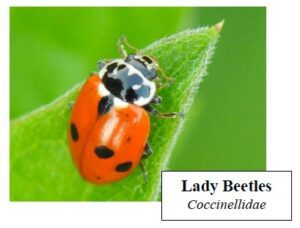 Appearance: Convergent lady beetles have variable spot numbers (0 – 13) and are recognized for their distinct “converging” white lines on their pronotum (the section between head and wings). Seven-spotted lady beetles are more circular in shape and will always have seven spots. Larvae of both species are soft-bodied, mostly black with orange markings, and have an “alligator-like” appearance. Eggs are bright yellow, football-shaped, and laid in clusters. Pupae are red to orange with spots and are affixed to surfaces at their base. Adults are 1/4 inch long. Larvae are 1/8 to 3/8 inch long.
Appearance: Convergent lady beetles have variable spot numbers (0 – 13) and are recognized for their distinct “converging” white lines on their pronotum (the section between head and wings). Seven-spotted lady beetles are more circular in shape and will always have seven spots. Larvae of both species are soft-bodied, mostly black with orange markings, and have an “alligator-like” appearance. Eggs are bright yellow, football-shaped, and laid in clusters. Pupae are red to orange with spots and are affixed to surfaces at their base. Adults are 1/4 inch long. Larvae are 1/8 to 3/8 inch long.
Life Cycle: Egg – Larva (4 stages) – Pupa – Adult.
Benefits: Lady beetles are attracted to the honeydew excretions produced by aphids. Both adults and larvae will voraciously consume these pests. Lady beetles can defend themselves by exuding a yellow toxin through the joints of their exoskeleton in a process known as “reflex bleeding.”
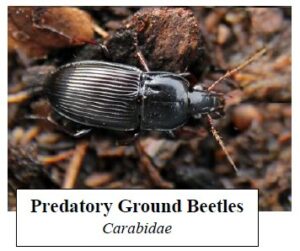 Appearance: Body shapes and sizes can vary within this diverse group of beetles. Most are generally dark in color (black to red) and sometimes shiny. Most have prominent mandibles, long antennae, and long legs. Adults can range in size from 1/4 to 1 1/4 inch long.
Appearance: Body shapes and sizes can vary within this diverse group of beetles. Most are generally dark in color (black to red) and sometimes shiny. Most have prominent mandibles, long antennae, and long legs. Adults can range in size from 1/4 to 1 1/4 inch long.
Life Cycle: Egg – Larva – Pupa – Adult.
Benefits: In general, these predaceous beetles are nocturnal and prefer to hunt along the ground in sheltered areas, but can sometimes be found in the canopy of plants looking for prey. Larvae are also predatory and primarily ground-dwelling. Predatory ground beetles will eat a wide range of prey items including aphids, caterpillars, grubs, mites, and spiders. They are voracious eaters and can consume close to their body weight in food daily.
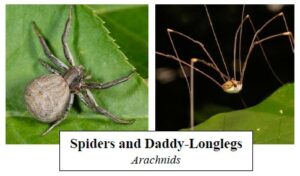 Appearance: Unlike insects, spiders have only two body segments, the cephalothorax (fused head and thorax) and abdomen. They also possess silk glands used for silk production, eight legs, and a pair of chelicerae which are used to inject venom into prey. Daddy-longlegs (Opiliones) are commonly mistaken for spiders. Daddy-longlegs belong to a separate group of arachnids that are more closely related to scorpions than they are to spiders. Unlike spiders, daddy-longlegs only have one body section, do not possess venom or silk glands, and cannot produce webs.
Appearance: Unlike insects, spiders have only two body segments, the cephalothorax (fused head and thorax) and abdomen. They also possess silk glands used for silk production, eight legs, and a pair of chelicerae which are used to inject venom into prey. Daddy-longlegs (Opiliones) are commonly mistaken for spiders. Daddy-longlegs belong to a separate group of arachnids that are more closely related to scorpions than they are to spiders. Unlike spiders, daddy-longlegs only have one body section, do not possess venom or silk glands, and cannot produce webs.
Benefits: Alfalfa provides a habitat for numerous species of spiders. Spiders can be categorized based on their foraging styles such as trapping or web-building (orb-weavers), ambushing (crab spiders), and active hunting (wolf spiders and jumping spiders). Spiders are generalists and will prey on a variety of arthropods. Daddy-Longlegs are omnivorous and will feed on fungi, decaying matter, and small arthropods such as springtails, mites, and aphids. They all play an important role in overall pest suppression in alfalfa.
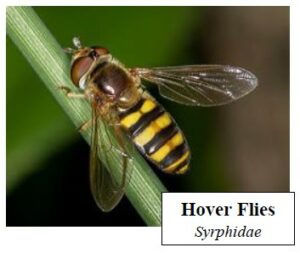 Appearance: Hover flies have bright yellow and black markings which can make them easy to mistake for bees or wasps. To distinguish between the two, flies will have a stubby antenna and only one pair of wings (bees and wasps have two pairs of wings). Hover flies also have large eyes which tend to take up much of the head. Hover fly larvae are slug-like in appearance and vary in color from brown to green to yellow. Some larvae have a pale yellow dorsal stripe, which can make them superficially similar in appearance to alfalfa weevil larvae. Adult flies are about 1/2 inch in length while larvae can be between 1/16 – 1/2 inch long.
Appearance: Hover flies have bright yellow and black markings which can make them easy to mistake for bees or wasps. To distinguish between the two, flies will have a stubby antenna and only one pair of wings (bees and wasps have two pairs of wings). Hover flies also have large eyes which tend to take up much of the head. Hover fly larvae are slug-like in appearance and vary in color from brown to green to yellow. Some larvae have a pale yellow dorsal stripe, which can make them superficially similar in appearance to alfalfa weevil larvae. Adult flies are about 1/2 inch in length while larvae can be between 1/16 – 1/2 inch long.
Life Cycle: Egg – Larva (3 stages) – Pupa – Adult.
Benefits: Adult flies will feed on honeydew (aphid excrement), pollen, and nectar. They are important pollinators of flowers. Larvae, on the other hand, are effective predators of aphids. Prey are grasped with mouth hooks while the inner contents are removed. Females lay eggs near aphid colonies to ensure an adequate food source for their young.
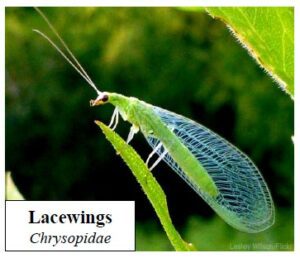 Appearance: Adults have transparent, delicately veined wings held roof-like over their bodies. Green lacewings are more common than brown lacewings. They have a long, slender antennae and protruding eyes. Larvae are mottled brown with a pair of prominent, sickle-shaped jaws. Green lacewing adults are 3/8 inch long and larvae range in size from 1/16 -1/2 inch long.
Appearance: Adults have transparent, delicately veined wings held roof-like over their bodies. Green lacewings are more common than brown lacewings. They have a long, slender antennae and protruding eyes. Larvae are mottled brown with a pair of prominent, sickle-shaped jaws. Green lacewing adults are 3/8 inch long and larvae range in size from 1/16 -1/2 inch long.
Life Cycle: Egg – Larva (3 stages) – Pupa – Adult. Lacewings can overwinter in their last larval stage in a cocoon.
Benefits: Adults will feed on pollen, nectar, and honeydew. Larvae, however, will voraciously consume a variety of soft-bodied insects, especially aphids. Hooked and hollow jaws are used to pierce prey, inject paralyzing venom, and suck up body contents. Larvae will sometimes attach debris to themselves for camouflage against predators and prey. Females will lay eggs in clusters with each egg perched upon a slender stalk.
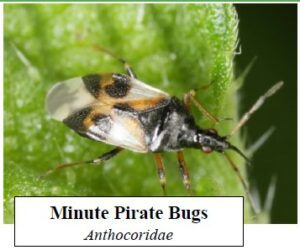 Appearance: These tiny insects have a flattened body that is oval to triangular in shape. Adults have a distinct black and white pattern on their wings, while nymphs can appear red to orange in color.
Appearance: These tiny insects have a flattened body that is oval to triangular in shape. Adults have a distinct black and white pattern on their wings, while nymphs can appear red to orange in color.
Adults are approximately 1/16 to 1/8 inch in length.
Life Cycle: Egg – Nymph (5 stages) – Adult.
Benefits: Despite their small size, these insects are important consumers of arthropod eggs, mites, aphids, thrips and other small pests. Their piercing- sucking mouthparts are used to suck up prey contents.
Now that we properly know how to identify pets vs. beneficial bugs, we can properly monitor and decide when to take action. If there is an abundance of pests and little to no beneficial bugs, it will be time to take action. The common practice is to use pesticides, but I want to throw out other options that won’t have a negative impact on the environment.
Biocontrol (AKA: biological control) is using a pests’ natural enemy to fend off the pests. All the beneficial bugs listed above can be thrown into the field to control pests as they feed off of them. For example, if there is an alfalfa field that is being attacked by aphids, you can bring in damsel bugs, lady beetles, predatory ground beetles, spiders, daddy-longlegs, hover flies, lacewings, and/or minute pirate bugs that all feed on aphids.
Beetle banks are a great way to keep natural predators to pests in your fields. A beetle bank is an elevated strip of land in the middle of the field, specifically created for insects. Beetle banks consist of long berms planted with native perennial bunch grasses and/or wildflowers which attract and support predaceous ground beetles and other beneficial insects. Decomposing wood can also be added to the beetle banks to enhance more habitat options for beetles and above-ground nesting bees. These beetle banks will help keep the pests out of your fields year after year.
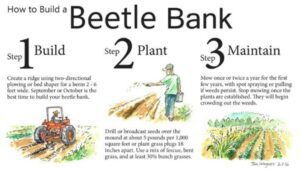 Garlic Barriers is another option to keeping the pests away. Garlic can be extracted into a liquid form and mixed with water to make a solution that can be easily sprayed over crops. Garlic repels many pests that are harmful to crops such as aphids, armyworms, caterpillars, chinch bugs, cutworms, grasshoppers, rootworms, leafhoppers, lygus bugs, mites, thirps, weevils, and webworms. It can also repel deer, field mice, and geese. They are not insect pests, but can still damage the crops. It imparts no garlic taste on any crops or plants that is sprayed with the garlic solution. Since it is all-natural, it is completely safe around people, pets, animals, fish, and the environment.
Garlic Barriers is another option to keeping the pests away. Garlic can be extracted into a liquid form and mixed with water to make a solution that can be easily sprayed over crops. Garlic repels many pests that are harmful to crops such as aphids, armyworms, caterpillars, chinch bugs, cutworms, grasshoppers, rootworms, leafhoppers, lygus bugs, mites, thirps, weevils, and webworms. It can also repel deer, field mice, and geese. They are not insect pests, but can still damage the crops. It imparts no garlic taste on any crops or plants that is sprayed with the garlic solution. Since it is all-natural, it is completely safe around people, pets, animals, fish, and the environment.
Biocontrol and garlic barriers are two ways of getting rid of pests that include so many more benefits than pesticides can. They are all low-cost, natural, sustainable, and safe ways to get rid of pests. There is no threat to human health, crop health, soil health, and beneficial organism.
Those were some ways to treat pests, but there is also a way to prevent pests from happening in the first place. It is known that vigorous, healthy plants have natural defenses against pests. Pests function in nature to eliminate the sick and unfit. Gary Zimmer wrote in his book The Biological Farmer, “The best long-range approach to crop pests and diseases is to not kill the attacking pests or pathogens, but to prevent the problem by correcting wrong soil conditions”. Healthier plants always start with correcting the soil. Once we get the soil aerated, salts balanced, and nutritionally balanced; then the plants will be balanced. The healthier the plant, the stronger the plant is to fight off the pests and pathogens.
View Bailey’s Bit About Nutrition as a PDF

